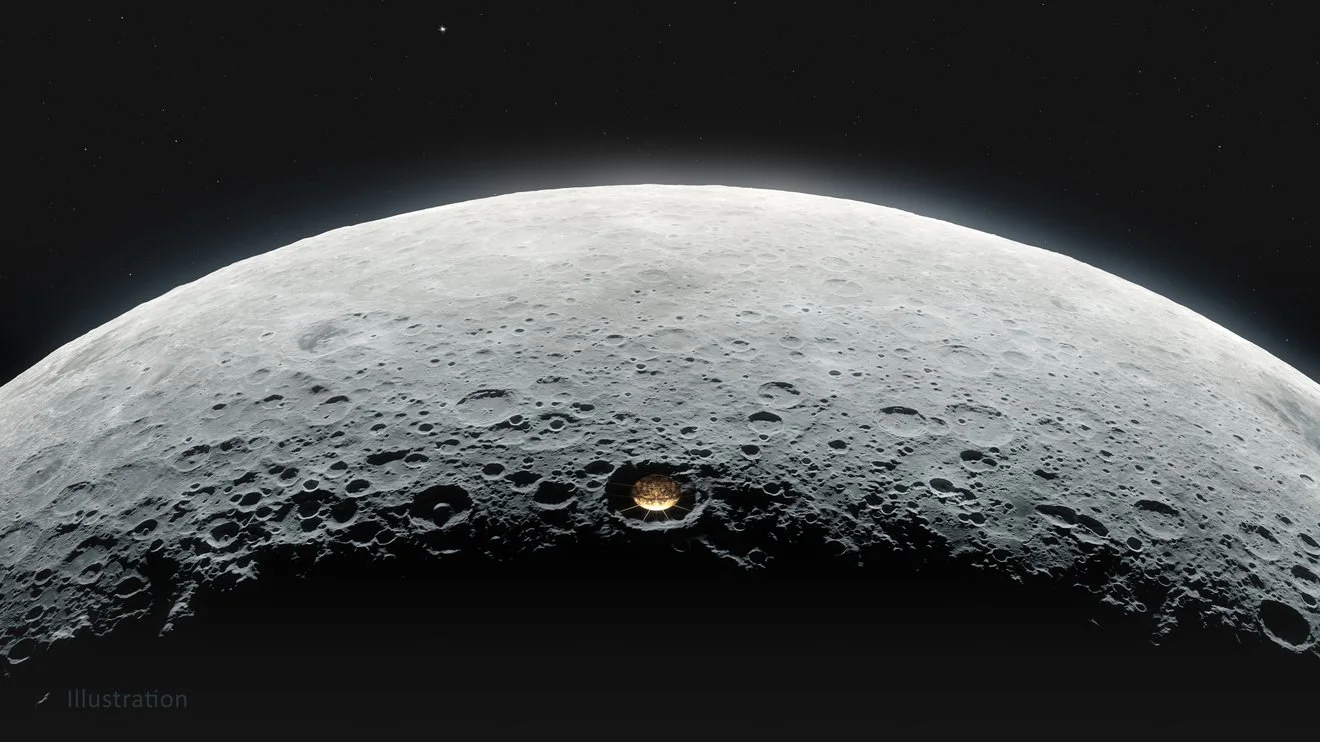
This lunar telescope could pull back the curtain on the cosmic dark ages
Converting an entire crater on the far side of the Moon into a radio telescope could reveal secrets from the Universe's earliest moments.
Escaping radio chatter on the far side of the Moon, a new telescope could allow astronomers to peer back into a time before the first stars ignited in the cosmos.
NASA has supported some ambitious projects in the past. Landing the first people on the Moon, putting a continuously inhabited space station in orbit, and flying a helicopter on Mars, are just three examples that immediately come to mind. Each of these has come with enormous payoffs for science, the space exploration community, and the public.
NASA's Innovative Advanced Concepts (NIAC) program just backed another project that would convert a large crater on the far side of the Moon into an immense radio telescope. From this location, the aptly named Lunar Crater Radio Telescope could then pull back the curtain on a part of the universe that astronomers have never been able to explore before.
"While there were no stars, there was ample hydrogen during the universe's Dark Ages – hydrogen that would eventually serve as the raw material for the first stars," Joseph Lazio, a radio astronomer at NASA's Jet Propulsion Laboratory, said in a statement. "With a sufficiently large radio telescope off Earth, we could track the processes that would lead to the formation of the first stars, maybe even find clues to the nature of dark matter."
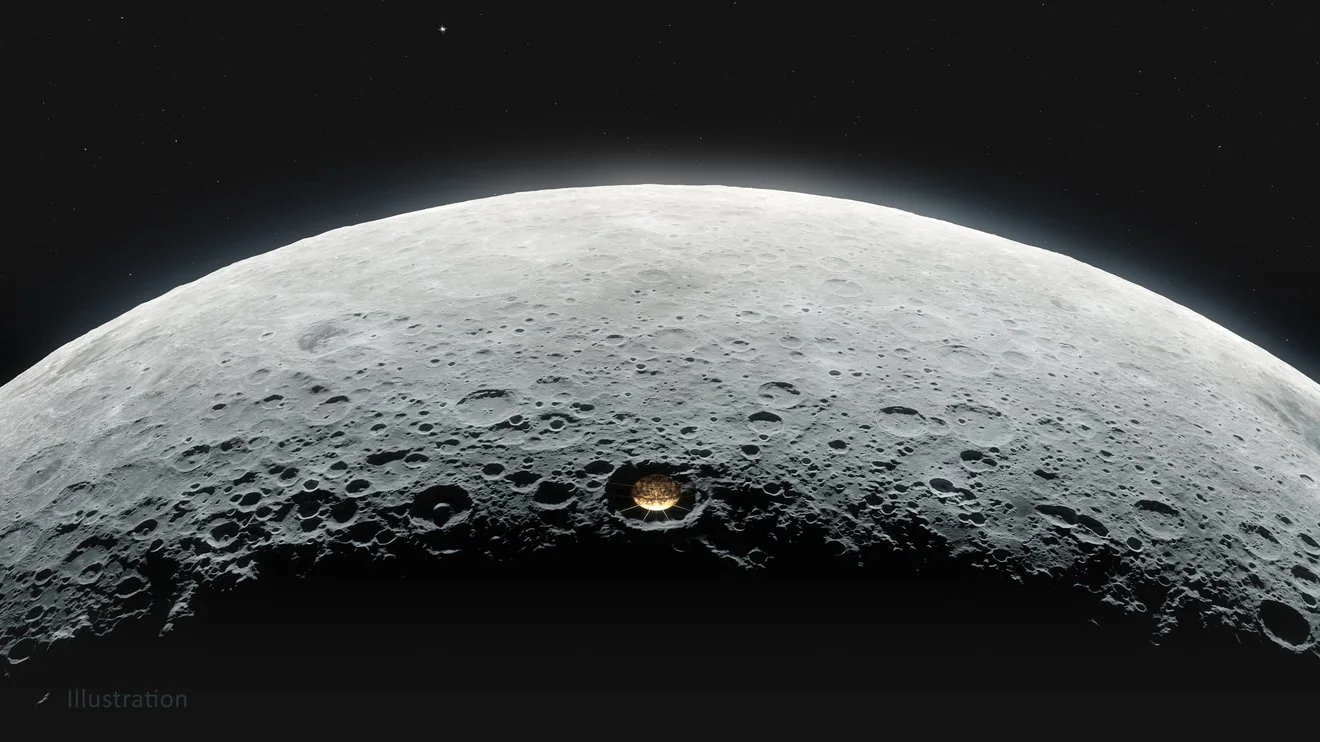
The Lunar Crater Radio Telescope (LCRT) would be the largest telescope ever built, in a location where nothing has ever been built before. Credit: Vladimir Vustyansky, c/o NASA
Radio telescopes are very useful for exploring the farthest reaches of the cosmos. This is because radio waves can slip past most obstacles, such as dust, which can scatter shorter wavelengths of light. However, there are three significant obstacles to using radio telescopes to explore the universe.
The first is the nature of the radio waves themselves. The farther radio waves travel through space, the more they become stretched out. That is, their wavelength becomes longer. So, to gather radio waves from objects really far away, astronomers need to build larger and larger telescopes. The Arecibo telescope in Puerto Rico was a little over 300 metres wide. China's new FAST radio telescope has a diameter of 500 metres, and Russia's RATAN-600 spans over 570 metres wide. The larger the telescope, the longer the wavelength of radio waves that can be collected. Thus, the farther away, and the farther back in time, you can look.
The second obstacle is Earth's atmosphere. As light falls on Earth from space — from gamma rays all the way to the longest radio waves — the atmosphere acts as a filter. There is a specific 'window' for radio waves, between around 1 millimetre up to just over 10 metres. These wavelengths can make it to the ground, but the rest is blocked out by Earth's ionosphere. Building your telescope higher up in the atmosphere, such as on a mountain top, can unlock some of the lower wavelengths, but not the higher ones.
"Radio telescopes on Earth cannot see cosmic radio waves at about 33 feet [10 meters] or longer because of our ionosphere, so there's a whole region of the universe that we simply cannot see," Saptarshi Bandyopadhyay, a robotics technologist at JPL who is leading the LCRT project, said in the press release.

This diagram shows the absorption of electromagnetic radiation by the atmosphere and the best place to position telescopes to observe different wavelengths. Credit: NASA
This brings us to the third obstacle, though. If you put a radio telescope on a satellite and launch it into Earth orbit, you would have to put up with the constant radio chatter from Earth interfering with observations.
There's one place you can go in space to escape that radio interference, though — the far side of the Moon.
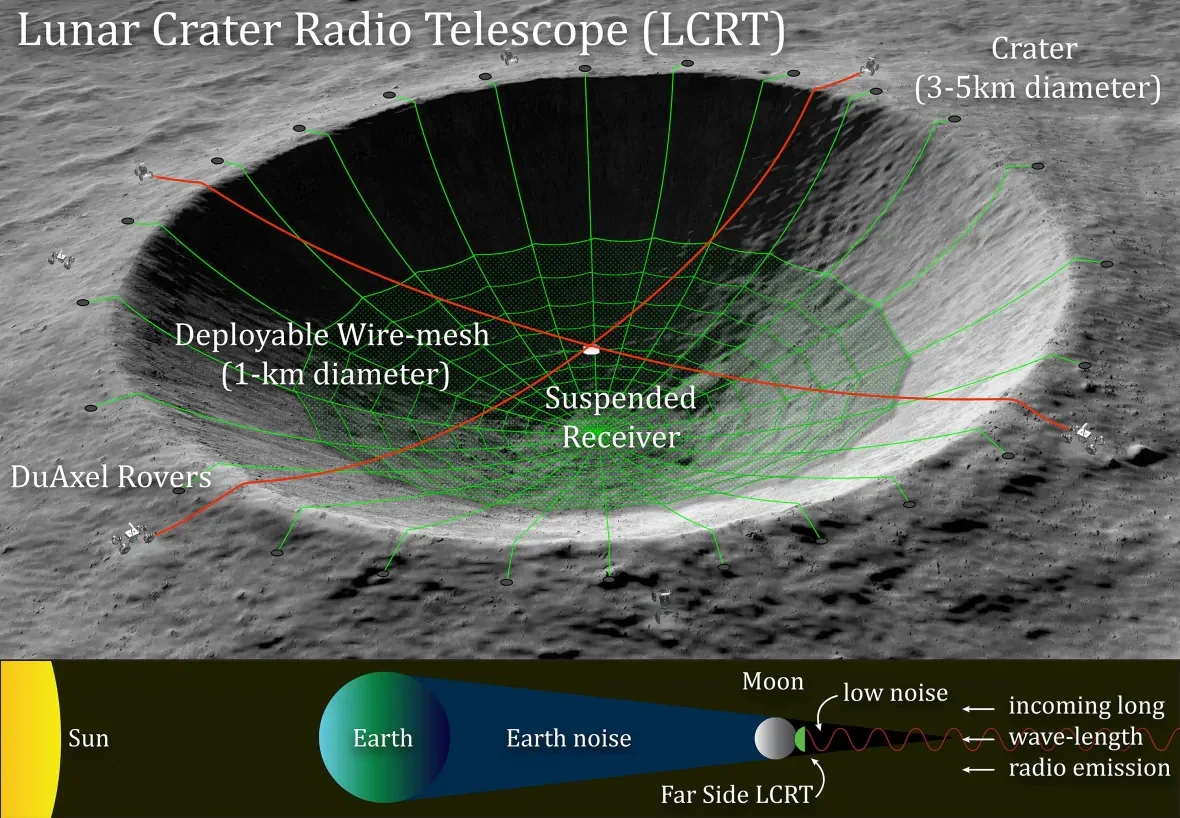
This concept drawing of the Lunar Crater Radio Telescope reveals its scale. Its location in the 'radio shadow' of the Moon provides key advantages for radio astronomers. Credit: Saptarshi Bandyopadhyay, c/o NASA
When the Apollo astronauts orbited the Moon, each time they slipped around the far side, the Moon acted as a physical barrier and breaking their radio contact with NASA. China's Chang'e 4 lander/rover mission, which landed on the far side of the Moon in January 2019, deals with this problem as well.
This 'radio silence' may be an issue to be overcome for other missions, but it's a key feature for a radio telescope. Also, since the far side of the Moon always faces away from Earth, the telescope would always be shielded from the planet's radio noise. The designers could pick any suitable crater to host it, and they would never have to move it from that spot. Similar to how Chang'e 4 communicates, astronomers would simply need a relay satellite stationed far outside the Moon's orbit to collect the data the telescope gathers.
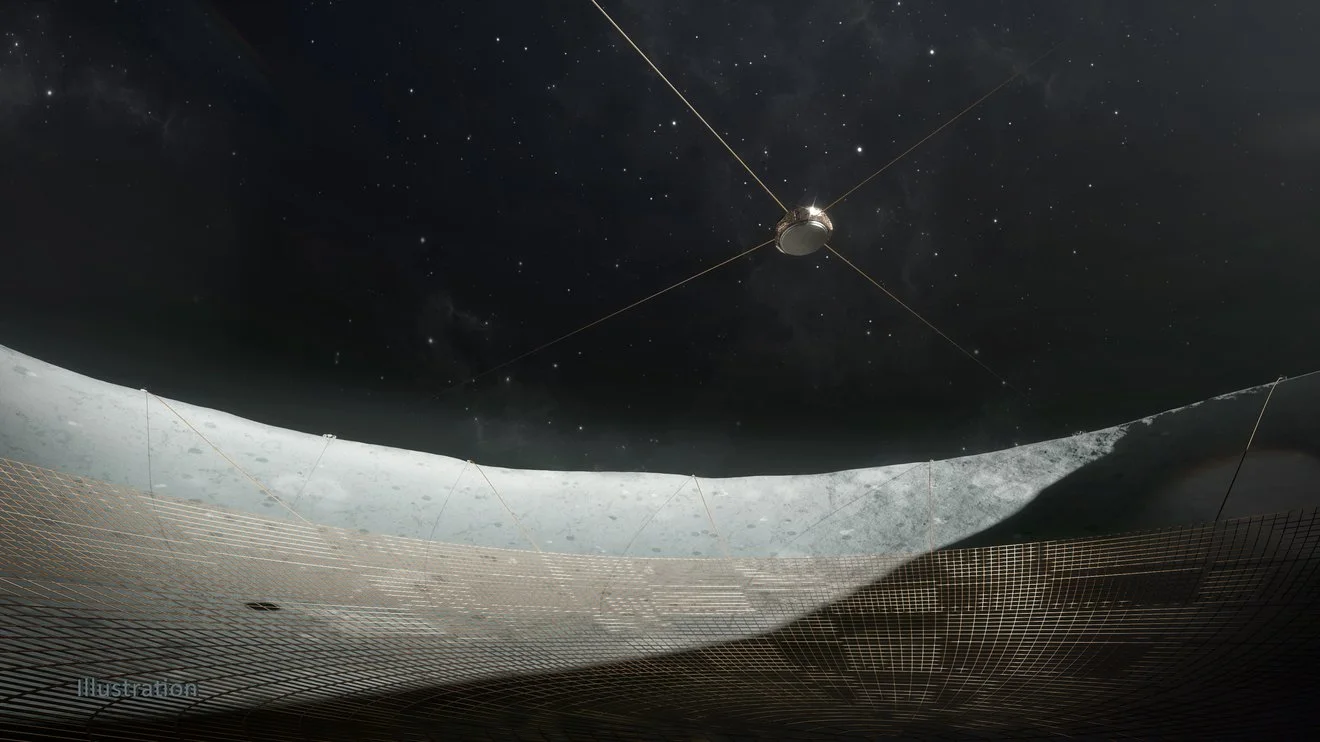
This illustration of the LCRT shows the fine mesh of the telescope 'disk' laid at the bottom of the crater, with the receiver antenna suspended high above the crater floor. Credit: Vladimir Vustyansky, c/o NASA
Given the complexity of building a telescope here on Earth, it's easy to think that building one on the Moon would be far beyond our capabilities.
"[P]revious ideas of building a radio antenna on the Moon have been very resource-intensive and complicated," Bandyopadhyay said, "so we were compelled to come up with something different."
The concept behind the LCRT is reasonably simple, though. Set a lander down at the centre of a crater on the far side of the Moon, accompanied by four specially designed DuAxel robot rovers. DuAxel was developed at JPL, specifically to tackle the challenge of climbing crater walls, and has already gone through field testing in the Mojave Desert.
According to NASA: " [DuAxel] is actually made of a pair of two-wheeled rovers, each called Axel. To divide and conquer, the rover stops, lowers its chassis and anchors it to the ground before essentially splitting in two. With the rear half of DuAxel (short for "dual-Axel") firmly in place, the forward half undocks and rolls away on a single axle. All that connects the two halves now is a tether that unspools as the lead axle approaches the hazard and rappels down the slope, using instruments stowed in its wheel hub to study a scientifically attractive location that would normally be out of reach."
Once these DuAxels are deployed, they drive themselves to the cardinal points around the crater rim and anchor there. Then, one Axel from each descends into the crater, links to a pair of guidewires from the lander, and drives part-way back up the crater slopes. Drawing in the first set of wires, the Axels would raise the radio receiver above the surface. Drawing in the second set of cables then unfurls the wire mesh 'dish' across the crater floor.
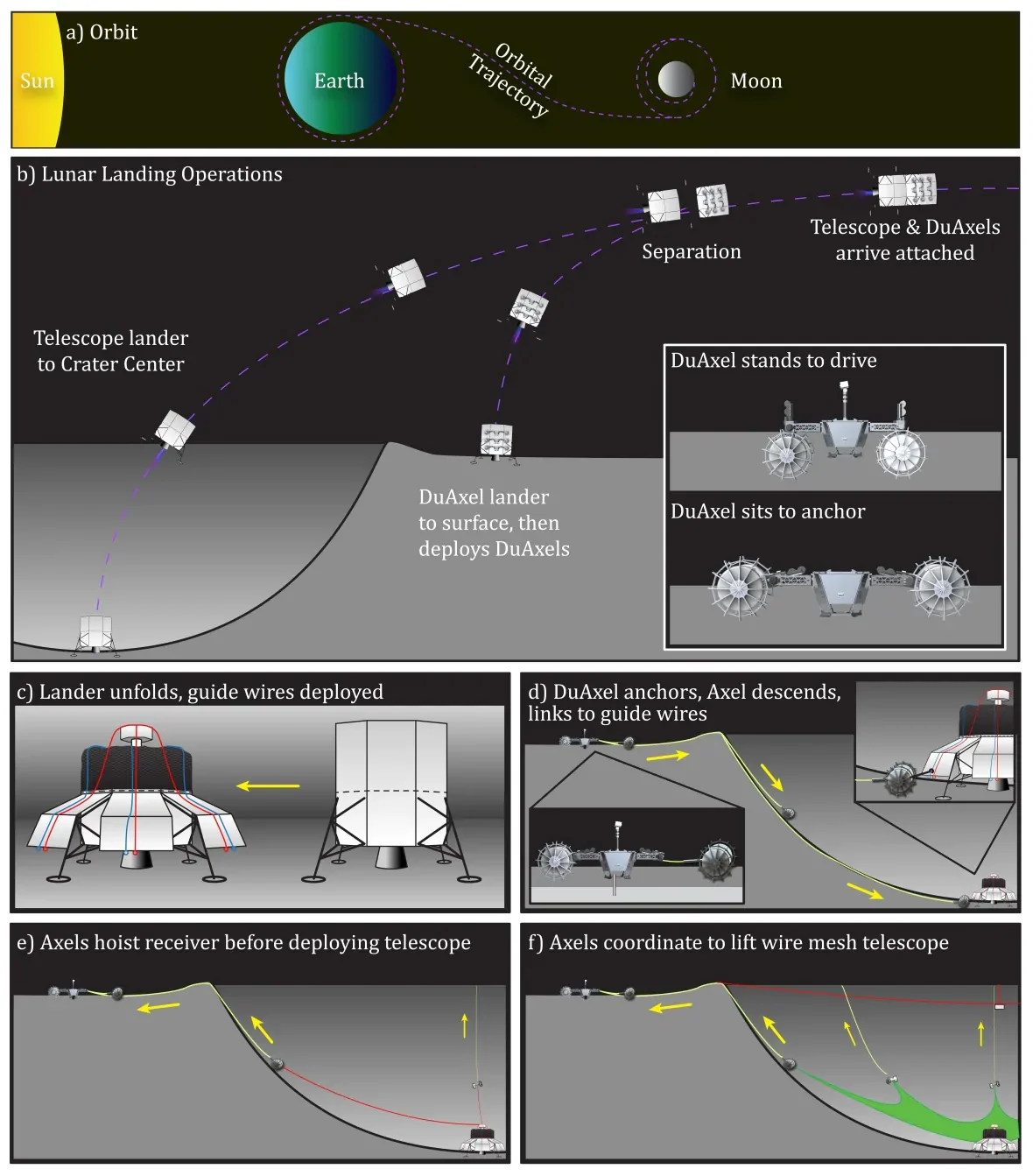
These concept drawings show how a robotic lunar mission would land and deploy the LCRT on the far side of the Moon. Credit: Saptarshi Bandyopadhyay, c/o NASA
The Lunar Crater Radio Telescope is still in the early concept stages at the moment. However, this new support from NASA gives the team two years to further investigate the idea. If they continue to receive support from the NIAC program in the future, we could one day see this telescope spring up, and DuAxels used to construct other projects on the Moon, Mars or beyond.
"The development of this concept could produce some significant breakthroughs along the way, particularly for deployment technologies and the use of robots to build gigantic structures off Earth," Bandyopadhyay said. "I'm proud to be working with this diverse team of experts who inspire the world to think of big ideas that can make groundbreaking discoveries about the universe we live in."






